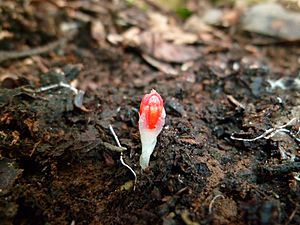Thismia rodwayi facts for kids
Quick facts for kids Thismia rodwayi |
|
|---|---|
 |
|
| Scientific classification | |
| Genus: |
Thismia
|
| Species: |
rodwayi
|
Thismia rodwayi, also known as the fairy lantern, is a very special plant. It doesn't have chlorophyll, which means it can't make its own food from sunlight like most plants. It belongs to the Burmanniaceae family.
You can find this unique plant in southern Australia, including Tasmania, Victoria, and New South Wales. It also grows in a few places in New Zealand. Because not many of these plants have been found, it's listed as "Rare" in Tasmania. However, a big group called the IUCN doesn't consider it threatened globally.
Contents
About the Fairy Lantern Plant
The fairy lantern plant is quite small and often hard to spot. It looks like a tiny reddish-yellow flower, almost as if it has no stem or leaves. You might see it popping up from the forest floor or hidden under a layer of leaves and twigs. Since it doesn't have chlorophyll, the main parts you see are just the flower and its roots, both without any green color.
This plant is a mycoheterotroph. This means it gets its food from a fungus that lives in the soil. The fungus helps the plant get nutrients from rotting organic material. Scientists are still learning a lot about its full life cycle, especially how it reproduces.
What the Fairy Lantern Looks Like
The common name, fairy lantern, really describes Thismia rodwayi well. It's a very tiny flower, usually orange and red. The main part is a tube shape, about 10 to 18 millimeters long. At the top of this tube are six petal-like parts called perianth lobes. Three of these curve inwards, while the other three spread outwards.
The flower sits on a stem that is 0.5 to 3 centimeters long. This stem is colorless and grows underground. It has six small leaf-like structures called bracts that get bigger closer to the flower. The stem grows from roots that are about 1 to 1.5 millimeters thick and 4 to 15 centimeters long.
Usually, each plant only produces one flower at a time, but sometimes it might grow two. You can often find these plants growing in small groups of 2 to 5, and sometimes up to 12, in an area smaller than one square meter.
Where Fairy Lanterns Live
Thismia rodwayi prefers wet eucalyptus forests. It's often found under trees like Eucalyptus obliqua, E. regnans, E. delegatensis, and E. viminalis. These plants grow at heights between 100 and 650 meters above sea level.
In Tasmania, areas where Thismia might grow are often identified as "tall E. obliqua forest" or "wet E. viminalis forest." Since we don't have many records of where the flower is found, its potential habitat is much larger than the places we know it actually grows.
Locally, good spots for Thismia have a thin tree canopy above them. The soil should be damp, dense, and firm, with a thick layer of fallen leaves and branches on top.
How Fairy Lanterns Reproduce
The life cycle of Thismia rodwayi is still a bit of a mystery. Since these plants often appear in small groups close together, scientists think that both their pollen and seeds don't travel very far. This might explain why the plant only grows in a small part of its possible habitat.
There are two main ideas about how Thismia rodwayi is pollinated:
- Insect Pollination: Small insects like fungus gnats might get trapped inside the flower's tube. To get out, they would have to squeeze through gaps near the anthers (the parts that hold pollen), covering themselves in pollen as they leave.
- Animal Pollination: Mammals like the potoroo (Potorous tridactylus) are known to eat roots and underground fungi in similar areas. They could accidentally carry pollen from one plant to another. Another possible animal helper could be the superb lyrebird (Menura novaehollandiae).
It's also possible that the plant spreads using underground stems called stolons.
How Fairy Lanterns Get Food
Even though people once thought Thismia rodwayi was a saprophyte (meaning it fed on dead matter directly), we now know it's a mycoheterotroph. This means it relies on a truly saprophytic fungus for its food. The tiny threads of the fungus, called hyphae, are found inside and around the plant's roots.
The fungus takes in nutrients from rotting organic material and stores them as fat. Then, the fungal cells release these fat droplets into the plant's cells. The plant then changes these fats into a type of sugar, possibly glycogen, to use as energy.
Why Fairy Lanterns Are Rare
Because we don't have much information about where this plant grows, the IUCN doesn't list Thismia rodwayi as threatened globally. However, it is listed as "Rare" in Tasmania under the Tasmanian Threatened Species Protection Act of 1995. This is because its natural populations are very small, making it vulnerable.
One big challenge in finding more of these plants is that they are often hidden. Even though they are brightly colored, they are usually covered by fallen leaves and other plant litter. This makes them easy to miss during regular plant surveys. However, better survey methods are helping scientists find more Thismia rodwayi plants, and we are slowly gathering more information.
Most of the places where Thismia rodwayi might grow are already protected, like in national parks or riverside reserves. It seems that normal forest activities, like cutting down some trees or controlled burning to help new trees grow, might not harm Thismia rodwayi. But if a forest is completely changed into a single type of tree plantation, it could be bad for these unique plants.
Images for kids



